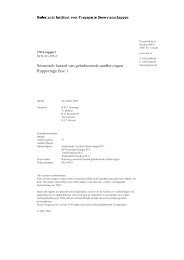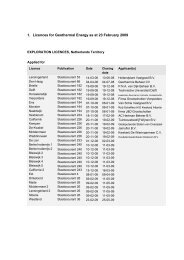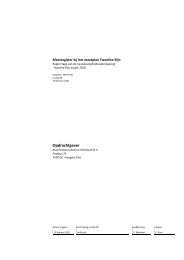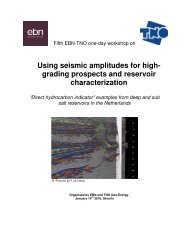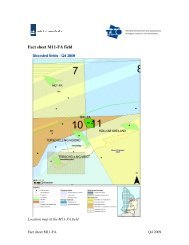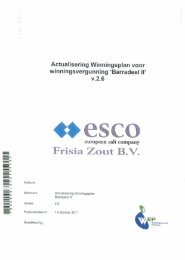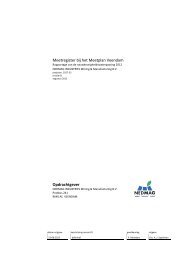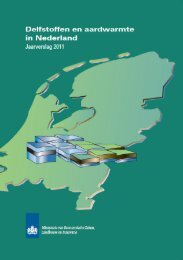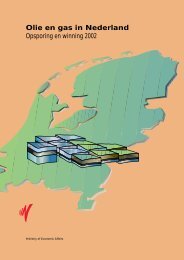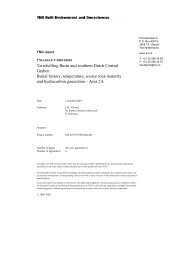Geometrical stacking for fluid contact analysis Examples from the ...
Geometrical stacking for fluid contact analysis Examples from the ...
Geometrical stacking for fluid contact analysis Examples from the ...
You also want an ePaper? Increase the reach of your titles
YUMPU automatically turns print PDFs into web optimized ePapers that Google loves.
<strong>Geometrical</strong> <strong>stacking</strong> <strong>for</strong> <strong>fluid</strong><br />
<strong>contact</strong> <strong>analysis</strong><br />
<strong>Examples</strong> <strong>from</strong> <strong>the</strong> North Sea<br />
Dutch sector<br />
* Suncor Ne<strong>the</strong>rlands<br />
Arnaud Huck<br />
Frits Blom*<br />
January 14, 2010
Outline<br />
Introduction<br />
Base Vlieland Shale example<br />
Top Middle Bunter example<br />
Top Rotliegend example<br />
Conclusions
Outline<br />
Introduction<br />
Base Vlieland Shale example<br />
Top Middle Bunter example<br />
Top Rotliegend example<br />
Conclusions
Common Contour Binning<br />
Objective:<br />
– Detect subtle hydro-carbon related anomalies and pin-point <strong>contact</strong>s<br />
(GWC, GOC and OWC)<br />
Principle:<br />
– Seismic traces that penetrate <strong>the</strong> top reservoir at <strong>the</strong> same depth (i.e.<br />
lie on <strong>the</strong> same contour line) have identical hydro-carbon columns.<br />
– Stacking traces along <strong>the</strong> same contour line thus enhances possible<br />
hydrocarbon effects while stratigraphic variations and noise are<br />
cancelled.<br />
CCB Outputs:<br />
– New 3D volume with stacked traces along contour lines<br />
– CCB stack = 2D section with stacked traces<br />
– Crossplot of stacked amplitudes vs. bin depth<br />
Developed by and <strong>for</strong>
CCB plugin principle<br />
polygon outlines<br />
area of investigation<br />
Amplitudes<br />
Seismic<br />
at top<br />
reservoir Stacked Amplitudes<br />
traces<br />
after traces at<br />
top will<br />
CCB<br />
be<br />
inside<br />
Top reservoir<br />
polygon are<br />
map<br />
<strong>stacking</strong><br />
stacked along<br />
re-distributed along<br />
contour lines<br />
contour lines<br />
Contour line<br />
Top reservoir
Outline<br />
Introduction<br />
Base Vlieland Shale example<br />
Top Middle Bunter example<br />
Top Rotliegend example<br />
Conclusions
Example 1: Base Vlieland Shale<br />
In this first example Common contour binning was applied<br />
around <strong>the</strong> Base Cretaceous Uncon<strong>for</strong>mity (Base Vlieland<br />
Shale) at a known prospect.<br />
The <strong>for</strong>mation below this uncon<strong>for</strong>mity is a good reservoir<br />
containing gas, while <strong>the</strong> <strong>for</strong>mation above is a regional<br />
seal.
Base Vlieland Shale depth map<br />
Contours every 5ms<br />
East-west size:<br />
2.6 km<br />
TWT in s.
Seismic amplitude map<br />
at Base Vlieland Shale<br />
A large low<br />
amplitude area is<br />
visible in <strong>the</strong><br />
nor<strong>the</strong>rn part<br />
It does not<br />
correspond<br />
completely with <strong>the</strong><br />
time structure map<br />
A second larger<br />
area show a quick<br />
amplitude decrease<br />
with polarity<br />
reversal<br />
Seismic amp.
CCB Stack, Area = entire survey<br />
Base Vlieland Shale<br />
The following observations<br />
can be made:<br />
1465ms: Drop of amplitude<br />
by 20%<br />
Low amplitudes between<br />
1465 and 1475ms<br />
Much larger drop of<br />
amplitudes between 1482 and<br />
1492ms<br />
Besides <strong>the</strong> small changes<br />
around 1465 ms an enormous<br />
amplitude change with phase<br />
reversal is observed.<br />
This change is not step-like<br />
but <strong>the</strong> inflexion point is<br />
located at 1486 ms. The<br />
change occurs within +/-2ms.
The large<br />
amplitude change<br />
is marked as <strong>the</strong><br />
limit between <strong>the</strong><br />
blue and green<br />
areas<br />
CCB Stack amplitude map<br />
Base Vlieland
Conclusions<br />
Base Vlieland Shale<br />
The CCB stack pattern features two amplitude anomalies at<br />
1465 and 1486ms.<br />
The amplitude change at 1465 ms is very subtle and<br />
cannot be confirmed on time data.<br />
The large amplitude anomaly at 1486 ms is considered<br />
typical behaviour <strong>for</strong> a CCB stack and could be interpreted<br />
as <strong>the</strong> position of <strong>the</strong> expected gas/water <strong>contact</strong>.<br />
This <strong>fluid</strong> <strong>contact</strong> has been confirmed by drilling: Prior to<br />
drilling <strong>the</strong> flat spot was estimated at 1496ms. The GWC in<br />
<strong>the</strong> well was actually found at 1489ms, much closer to <strong>the</strong><br />
CCB estimation.
Outline<br />
Introduction<br />
Base Vlieland Shale example<br />
Top Middle Bunter example<br />
Top Rotliegend example<br />
Conclusions
Top Middle Bunter<br />
Contours every 25ms<br />
TWT in s.
Seismic amplitude map<br />
at Top Middle Bunter<br />
The top of <strong>the</strong><br />
structure features<br />
high amplitudes<br />
Seismic amp.
2D CCB Stack<br />
Top Middle Bunter<br />
The <strong>analysis</strong> was run in and around<br />
<strong>the</strong> prospect. Its limit is around a<br />
bin depth of 1508ms.<br />
The CCB stack reveals a trend of<br />
decreasing amplitudes wrt bin<br />
depth.<br />
Never<strong>the</strong>less no clear amplitude<br />
change is visible.
Conclusions<br />
Top Middle Bunter<br />
The CCB stack at Top Middle Bunter shows smooth<br />
variations in amplitudes, somewhat decreasing with bin<br />
depth.<br />
This behaviour does not correspond to a saturation change<br />
in a <strong>for</strong>mation whose thickness is above tuning resolution.<br />
Decreasing/increasing amplitude with bin depth can be<br />
related to both thickness and saturation changes. Only<br />
<strong>for</strong>ward modelling can distinguish <strong>the</strong>m, hence common<br />
contour binning is not conclusive at Top Middle Bunter.
Outline<br />
Introduction<br />
Base Vlieland Shale example<br />
Top Middle Bunter example<br />
Top Rotliegend example<br />
Conclusions
Seismic data,<br />
random line through prospect<br />
5 km 2 (Rotliegend prospect)<br />
The Middle Bunter which is<br />
between Vlieland and<br />
Rotliegend is completely eroded<br />
at <strong>the</strong> top of <strong>the</strong> structure.<br />
Base Vlieland<br />
Top Rotliegend
Top Rotliegend<br />
The red polygon is<br />
delimiting <strong>the</strong> area of<br />
interest<br />
Contours every 25ms<br />
East-west size<br />
(prospect): 10 km<br />
Two areas are visible<br />
within <strong>the</strong> prospect,<br />
clearly separated by<br />
a normal fault with a<br />
70ms offset at top<br />
Rotliegend.<br />
TWT in s.<br />
TWT in<br />
sec.
Seismic amplitude map<br />
at Top Rotliegend<br />
Several blocks are<br />
visible within <strong>the</strong><br />
prospect.<br />
The crest features<br />
lower amplitudes<br />
than <strong>the</strong> sou<strong>the</strong>astern<br />
part.<br />
Seismic amp.<br />
TWT in<br />
sec.
Isopach<br />
Top Rotliegend - Base Vlieland Shale<br />
Several blocks are<br />
visible within <strong>the</strong><br />
prospect.<br />
Zero thickness<br />
at crest<br />
The high amplitudes<br />
are located in <strong>the</strong><br />
part where <strong>the</strong>re is<br />
an intermediate<br />
<strong>for</strong>mation between<br />
Vlieland and<br />
Rotliegend, around<br />
40ms TWT in<br />
thickness.<br />
Middle Bunter<br />
thickness:<br />
40+/-10ms<br />
Time difference in ms.<br />
TWT in<br />
sec.
CCB Stack, Area = all<br />
Top Rotliegend<br />
The bin depths outside<br />
(thus deeper than) <strong>the</strong><br />
prospect show again low<br />
amplitudes.<br />
The outer part of <strong>the</strong><br />
prospect and observed<br />
amplitude change is at<br />
1464ms TWT.
CCB Stack amplitude map<br />
Top Rotliegend<br />
CCB Stack combined <strong>from</strong> <strong>the</strong> 3 sub stacks<br />
Deep areas:<br />
Low amplitudes<br />
Top of <strong>the</strong> structure:<br />
Low amplitudes<br />
Second structure:<br />
High amplitudes
Seismic amplitude map<br />
at Top Rotliegend<br />
Several blocks are<br />
visible within <strong>the</strong><br />
prospect.<br />
The crest features<br />
lower amplitudes<br />
than <strong>the</strong> sou<strong>the</strong>astern<br />
part.<br />
Seismic amp.<br />
TWT in<br />
sec.
Pre-stack CCB<br />
Top Rotliegend<br />
CCB was applied to prestack<br />
data. The technique<br />
works similarly with offset<br />
as extra dimension.<br />
The display is limited to<br />
<strong>the</strong> horizon Z only.<br />
The vertical axis<br />
represent offsets (in m.)<br />
while <strong>the</strong> colours remain<br />
seismic amplitudes.<br />
A classical AVO graph<br />
would be a vertical slice<br />
on that panel.
Conclusions<br />
Top Rotliegend<br />
CCB <strong>stacking</strong> highlighted clear amplitude changes at 1406 and<br />
1464ms TWT, <strong>from</strong> <strong>the</strong> post and pre-stack data.<br />
The structure is divided in two by a normal fault that appears to<br />
be a lateral seal, since high amplitudes are observed in <strong>the</strong> south<br />
east compartment that are not present in <strong>the</strong> crest, nei<strong>the</strong>r at <strong>the</strong><br />
same depth nor shallower.<br />
There<strong>for</strong>e three areas may be distinguished:<br />
– The crest is a Rotliegend/Vlieland <strong>contact</strong>, with low amplitudes<br />
– The outer part of <strong>the</strong> prospect is a Rotliegend/Bunter <strong>contact</strong><br />
with low amplitudes.<br />
– The south-eastern part of <strong>the</strong> prospect is a Rotliegend/Bunter<br />
<strong>contact</strong> with much higher amplitudes.
Conclusions<br />
Top Rotliegend<br />
While <strong>the</strong> amplitude change at 1406ms could be attributed<br />
to a lithology change ra<strong>the</strong>r than to a <strong>fluid</strong> <strong>contact</strong>, <strong>the</strong><br />
second amplitude change at 1464ms cannot be explained<br />
by a lithology change based on <strong>the</strong> available interpretations<br />
and <strong>the</strong> observed structures.<br />
There<strong>for</strong>e <strong>the</strong> CCB results and structural in<strong>for</strong>mation<br />
indicate that <strong>the</strong> south-eastern part of <strong>the</strong> prospect is gas<br />
filled with an up-dip seal along <strong>the</strong> normal fault in <strong>the</strong><br />
north-west, and a gas-water <strong>contact</strong> at 1464ms +/-4ms.
Outline<br />
Introduction<br />
Base Vlieland Shale example<br />
Top Middle Bunter example<br />
Top Rotliegend example<br />
Conclusions
Conclusions<br />
Common contour binning highlights subtle <strong>fluid</strong>-related seismic anomalies<br />
and allows delineating <strong>fluid</strong> <strong>contact</strong>s with more accuracy. However, <strong>the</strong><br />
technique in isolation cannot uniquely prove <strong>the</strong> presence (or absence) of<br />
hydrocarbons.<br />
The first and last example showed how gas water <strong>contact</strong>s can be picked<br />
with confidence, at Base Vlieland Shale and Top Rotliegend, respectively.<br />
However, <strong>the</strong> second example shows also how difficult <strong>the</strong> interpretation<br />
can be when <strong>the</strong> amplitude increases or decreases monotonously with bin<br />
depth. Such difficult cases cannot be interpreted with merely <strong>the</strong><br />
application of common contour binning. They require fur<strong>the</strong>r study<br />
including additional structural in<strong>for</strong>mation and sensitivity analyses.<br />
Fur<strong>the</strong>rmore, <strong>the</strong>re is a significant risk at using this geometrical <strong>stacking</strong><br />
technique outside of <strong>the</strong> original depth domain, <strong>the</strong>re<strong>for</strong>e it is always<br />
recommended to go in <strong>the</strong> depth domain when possible.




